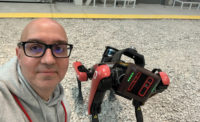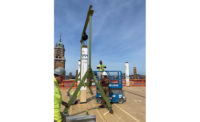
Related Article:
LIFTbuild’s Joe Benvenuto Talks Exchange, Top-Down Construction
Back to:
25 Top Newsmakers
Joe Benvenuto spent four years perfecting the “top-down” superstructure construction technology of LIFTbuild before work began in late 2021 on Exchange, a 207-ft-tall residential mid-rise in Detroit. The unorthodox method relies on building completed floor levels on the ground and lifting them into place around cores, using strand jacks.
“The system is advantageous because it offers a significant reduction in labor hours and improvements in safety from building on the ground and not at height,” says Benvenuto, chief operating officer of LIFTbuild, a wholly owned subsidiary of Barton Malow. “Applying Lean Construction principles allowed us to use the advantages of just-in-time delivery, better design documents and less costly installation of building systems.”
The 16-story project, completed last February, would have been difficult, at best, to construct on its triangular, ¾-acre site, Benvenuto says. It is bordered by city streets and businesses on all sides, and Detroit’s adjacent elevated people mover eliminated the use of a tower crane.
Process Efficiencies
Benvenuto began his career in Barton Malow’s self-perform operations and worked his way up to vice president overseeing major industrial and energy programs. He was eager to incorporate the process efficiencies of prefabrication and manufacturing methods in its construction, as well as the lifting, and brought on a Lean consultant to track all of the gains made over conventional delivery.
“I always refer to the whole lifecycle of the project,” the way the building is designed, procured, manufactured and then, eventually, lifted, says Benvenuto.
Previous work as a project executive on automotive manufacturing jobs in Michigan set the stage for LIFTbuild because they require similar attention to the process, related to production lines. “We try to point out some of the little things we do from kitting and storage and deliveries that would mimic more of an assembly line, rather than a half acre of laydown area,” Benvenuto says.

Joe Benvenuto
Photo courtesy of LIFTbuild
Exchange is a proof-of-concept. Benvenuto led LIFTbuild as both design-builder and development partner on the project. He helped the company secure 15 patents for both top-down construction and manufacturing processes.
Benvenuto encourages everyone at LIFTbuild to adopt new process-based terminology, such as calling the concrete cores “spines” instead of cores, because the cores serve as a spine, similar to a human’s. The walls of the spines are 10 in. to 1 ft thick. Every steel-framed floor deck of Exchange contains more than 75 tons of steel and 110 cu yd of concrete. Eight strand jacks lifted the 11,000-sq-ft floor plates, each weighing 500 tons.
Everyone at LIFTbuild “wanted to learn every aspect of this. They treated it like a prototypical job where they weren’t going to go out of their way to just prove its efficacy in terms of profitability,” says Mark Tamaro, managing director of structural engineer Thornton Tomasetti’s mid-South region. “They were going to put in the homework to really make sure that we were doing it right,” Tamaro adds, saying that Benvenuto understood how each trade was affected by the process.
LIFTbuild is talking to developers interested in taking advantage of the methodology and is helping clients understand that while it’s a different way of building, safety protocols and many other processes are the same as with any other project, Benvenuto says.
All ENR 2023 Top 25 Newsmakers will be honored at the Award of Excellence Gala on April 11 in New York City.






Post a comment to this article
Report Abusive Comment